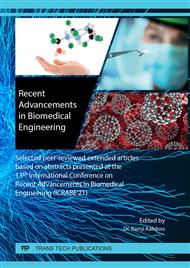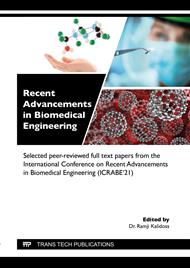[1]
S. Achilefu, Lighting up tumors with receptor-specific optical molecular probes, Technol. Cancer Res. T., 3 (2004) 393–409.
DOI: 10.1177/153303460400300410
Google Scholar
[2]
D.R. Elias, D. Thorek, A. K. Chen, J. Czupryna and A. Tsourkas, In vivo imaging of cancer biomarkers using activatable molecular probes, Cancer Biomark., 4 (2008) 287–305.
DOI: 10.3233/cbm-2008-4602
Google Scholar
[3]
K.C. Liu, B. S. Lin and X. P. Lan, J. Cell. Biochem., 114 (2013) 250– 255.
Google Scholar
[4]
W.H. Tan, M. J. Donovan, and J. H. Jiang, Aptamers from cell-based selection for bioanalytical applications, Chem. Rev., 113 (2013) 2842 −2862.
DOI: 10.1021/cr300468w
Google Scholar
[5]
Z. W. Tang, D. Shangguan, K. M. Wang, H. Shi, K. Sefah, P. Mallikratchy, H. W. Chen, Y. Li and W. H. Tan, Selection of aptamers for molecular recognition and characterization of cancer cells, Anal. Chem., 79 (2007) 4900–4907.
DOI: 10.1021/ac070189y
Google Scholar
[6]
P. Wu, Y. Gao, Y. Lu, H. Zhang and C. X. Cai, Analyst, 138 (2013) 6501–6510.
Google Scholar
[7]
K. Sefah, Z. W. Tang, D. H. Shangguan, H. Chen, D. Lopez-Colon, Y. Li, P. Parekh, J. Martin, L. Meng, J. A. Phillips, Y. M. Kim and W. H. Tan, Molecular recognition of acute myeloid leukemia using aptamers, Leukemia, 23 (2009) 235–244.
DOI: 10.1038/leu.2008.335
Google Scholar
[8]
Z. H. Sheng, D. H. Hu, P. F. Zhang, P. Gong, D. Y. Gao, S. H. Liu and L. T. Cai, Chem. Commun., Cation exchange in aptamer-conjugated CdSe nanoclusters: a novel fluorescence signal amplification for cancer cell detection, 48 (2012) 4202–4204.
DOI: 10.1039/c2cc00033d
Google Scholar
[9]
H. Y. Liu, S. M. Xu, Z. M. He, A. P. Deng and J. J. Zhu, Supersandwich Cytosensor for Selective and Ultrasensitive Detection of Cancer Cells Using Aptamer-DNA Concatamer-Quantum Dots Probes, Anal. Chem., 85 (2013) 3385–3392.
DOI: 10.1021/ac303789x
Google Scholar
[10]
X. L. Zhu, Y. Cao, Z. Q. Liang and G. X. Li, Aptamer-based and DNAzyme-linked colorimetric detection of cancer cells, Protein Cell, 1 (2010) 842– 846.
DOI: 10.1007/s13238-010-0110-2
Google Scholar
[11]
G. D. Liu, X. Mao, J. A. Phillips, H. Xu, W. H. Tan and L. W. Zeng, Aptamer−Nanoparticle Strip Biosensor for Sensitive Detection of Cancer Cells, Anal. Chem., 81 (2009) 10013–10018.
DOI: 10.1021/ac901889s
Google Scholar
[12]
S. Bamrungsap, T. Chen, M. I. Shukoor, Z. Chen, K. Sefah, Y. Chen and W. H. Tan, Pattern Recognition of Cancer Cells Using Aptamer-Conjugated Magnetic Nanoparticles, ACS Nano, 6 (2012) 3974–3981.
DOI: 10.1021/nn3002328
Google Scholar
[13]
Y. Zhu, P. Chandra and Y. B. Shim, Ultrasensitive and Selective Electrochemical Diagnosis of Breast Cancer Based on a Hydrazine–Au Nanoparticle–Aptamer Bioconjugate, Anal. Chem., 85 (2013) 1058–1064.
DOI: 10.1021/ac302923k
Google Scholar
[14]
Z. Yi, X.-Y. Li, Q. Gao, L.-J. Tang and X. Chu, Analyst, 138 (2013) 2032–(2037).
Google Scholar
[15]
Y. J. Song, W. L. Wei and X. G. Qu, Colorimetric biosensing using smart materials, Adv. Mater., 23 (2011) 4215–4236.
DOI: 10.1002/adma.201101853
Google Scholar
[16]
T. Li, B. L. Li, E. K. Wang and S. J. Dong, G-quadruplex-based DNAzyme for sensitive mercury detection with the naked eye, Chem. Commun., (2009) 3551–3553.
DOI: 10.1039/b903993g
Google Scholar
[17]
C. D. Medley, J. E. Smith, Z. Tang, Y. Wu, S. Bamrungsap and W. H. Tan, Gold Nanoparticle-Based Colorimetric Assay for the Direct Detection of Cancerous Cells, Anal. Chem., 80 (2008) 1067–1072.
DOI: 10.1021/ac702037y
Google Scholar
[18]
W. T. Lu, S. R. Arumugam, D. Senapati, A. K. Singh, T. Arbneshi, S. A. Khan, H. T. Yu and P. C. Ray, Multifunctional Oval-Shaped Gold-Nanoparticle-Based Selective Detection of Breast Cancer Cells Using Simple Colorimetric and Highly Sensitive Two-Photon Scattering Assay, ACS Nano, 4 (2010) 1739–1749.
DOI: 10.1021/nn901742q
Google Scholar
[19]
H. Q. Wang, W. Y. Liu, Z. Wu, L. J. Tang, X. M. Xu, R. Q. Yu and J. H. Jiang, Anal. Chem., 83 (2011) 1883–1889.
Google Scholar



